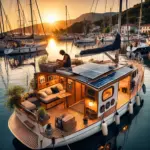atGPT
“Discover the enchanting world of living on a boat with our comprehensive blog. Explore the captivating journey of liveaboard sailing, the unique charm of stationary boat homes, and the creative intricacies of DIY boat living. Uncover insights into this lifestyle choice that blends adventure with simplicity, requiring preparation and adaptation. Dive into the joys and challenges of life on the water, and find out how it represents the ultimate escape from the ordinary. Join us as we navigate through the practicalities and romance of making the sea your home. Perfect for sea-lovers and dreamers alike, seeking a life less ordinary.”( PC MINI)
Embracing the Waves: The Comprehensive Guide to Living on a Boat
Introduction Imagine waking up to the gentle rocking of waves, the sound of seagulls overhead, and the refreshing tang of salt in the air. For many, the idea of living on a boat is synonymous with ultimate freedom—an escape from the rat race and a step into a life filled with adventure. But beyond the romantic allure, boat living is a lifestyle choice that requires preparation, adaptation, and a willingness to embrace both its joys and challenges. This blog dives into the essence of liveaboard sailing, explores the charm of stationary boat homes, and unveils the secrets of DIY boat living.
Section 1: Liveaboard Sailing
The Liveaboard Sailing Lifestyle Choosing a life on the water means more than simply being in love with the ocean—it’s about a commitment to a way of life that is both challenging and rewarding. Liveaboard sailors often speak of the profound sense of freedom they feel, unbound by traditional constraints of property and proximity. Yet, this freedom comes with a responsibility: to the sea, to their vessel, and to themselves.
Choosing the Right Vessel A key decision in the liveaboard lifestyle is selecting the right sailboat. It’s not just about size or style, but about finding a vessel that suits your needs for space, speed, and safety. It should be seaworthy for the waters you plan to navigate, have ample storage for long voyages, and possess a layout that feels like home. Whether it’s a monohull with its classic appeal or a catamaran known for its stability and space, your boat will be your constant companion.
Navigation and Mooring Understanding the basics of navigation is essential for liveaboard sailors. Modern GPS systems have simplified plotting a course, but the traditional skills of reading charts, understanding tides, and knowing your latitude and longitude remain invaluable. Equally important is knowledge about mooring rights and the regulations that govern where you can anchor, for both practical and legal reasons.
Community and Solitude Living at sea offers a unique opportunity to find harmony between community and solitude. While the vastness of the ocean offers a solitary retreat, the liveaboard community is a tight-knit group, sharing anchorages and experiences. It’s a culture rich in camaraderie and mutual assistance, where sailors share knowledge and stories in equal measure.
Section 2: Boat Homes
Stationary Serenity While some choose the itinerant sailor’s life, others find their bliss in stationary boat homes. Docked in marinas or along riverbanks, these floating residences offer the stability of a fixed address with the benefits of being on the water. Residents enjoy the tranquility of the water and often form close-knit communities with their dock neighbors.
Designing Your Water-Based Home Boat homes challenge you to think creatively about space. Every inch matters, and multifunctional furniture becomes a necessity. Designing for a marine environment means considering moisture-resistant materials and securing belongings against the sway of the water. Yet, the constraints can inspire incredible creativity, leading to cozy, efficient living spaces that reflect the personality of their owners.
Utility Management The logistics of managing utilities on a boat require planning and innovation. Options for electricity range from shore power connections to solar panels and wind generators. Water usage must be carefully managed, with conservation a priority, and sewage treated through on-board systems or marina facilities. Internet connectivity, once a challenge for boat homes, has become more accessible through cellular data plans and marina Wi-Fi networks.
Legalities and Logistics The dream of living on a boat is bound by the practicalities of law and logistics. Ensuring your vessel is legally documented and insured is a must, and you’ll need to be mindful of registration requirements and bylaws, which can vary widely by location. Understanding these aspects is crucial to a hassle-free life on the water.
Section 3: DIY Boat Living
The DIY Approach For the hands-on enthusiast, DIY boat living can be an immensely rewarding experience. It’s about taking full ownership of your living space—maintaining, repairing, and upgrading your vessel with your own hands. This self-sufficient approach is not only gratifying but also instills a deep understanding of your boat’s workings, which is invaluable in remote locations.
Customization and Repairs The ability to customize your boat to meet your specific living needs is one of the joys of DIY boat living. From installing energy-efficient appliances to building custom storage solutions, the modifications you make can enhance both functionality and comfort. Routine maintenance and timely repairs are also part of the DIY ethos, ensuring the safety and longevity of your home on the water.
Cost-Effectiveness and Budgeting Living aboard a boat can be as expensive or as economical as you make it. DIY living skews toward the latter, as doing your own repairs and upgrades can significantly cut costs. A clear budget that accounts for maintenance, docking fees, and living expenses will keep you afloat financially.
Learning and Growth The DIY boat life is a journey of continuous learning. From mastering knot-tying to understanding marine electrical systems, the skills you acquire are both necessary and empowering. Online forums, books, and local workshops can be excellent resources, and fellow liveaboards are often willing to share their expertise.
Conclusion
Choosing to live on a boat is to choose a life less ordinary. It’s a path that promises unparalleled freedom, natural beauty, and personal growth. Whether you’re drawn to the adventure of sailing, the community of a boat home, or the self-reliance of DIY living, the waterways of the world offer a backdrop against which you can write your own story.
Call to Action
Are you considering making the leap into boat living, or are you already riding the waves? Share your experiences or questions below, and join a community of waterborne wanderers just like you. For more insights into unconventional living and adventures on the high seas, keep following our blog.
This expanded post is a comprehensive look at the liveaboard lifestyle, covering the key aspects that one would need to consider when thinking about making a boat their home. Each section provides a blend of practical advice and philosophical musings on the unique joys and challenges of life on the water.
Learning and Growth (Continued)
The sea is both a stern teacher and a generous mentor. As a DIY boat liver, you’re constantly learning—whether it’s figuring out how to fix a leaky hatch, tuning your rigging for optimal performance, or learning the best way to navigate through a storm. There’s a wealth of knowledge available in the form of online tutorials, boating courses, and books penned by seasoned sailors. However, the most impactful lessons often come from experience and the shared wisdom of the boating community. Marinas and anchorages are melting pots of knowledge where stories and advice are exchanged over sundowners. Here, you’re not just developing practical skills; you’re growing in resilience, resourcefulness, and adaptability.
Cost-Effectiveness and Budgeting (Continued)
One of the misconceptions about boat living is that it’s an expensive endeavor. While this can be true, especially if you’re constantly traveling to new marinas or requiring professional maintenance, a DIY approach can significantly reduce costs. Thrifty liveaboards often trade skills, barter with other boaters, and learn how to stretch every dollar. They prioritize expenses, invest in quality equipment that lasts longer, and often find that their living costs are lower than on land. Of course, unexpected expenses can arise—like a sudden engine repair or hull maintenance—so savvy budgeters always set aside a contingency fund.
Customization and Repairs (Continued)
A boat is more than just a vehicle; it’s a canvas for expression. For the DIY enthusiast, every repair is an opportunity to improve and every customization a chance to personalize. It’s about making a space that’s not just functional but also feels like home. From simple modifications like adding extra shelving for storage to more complex upgrades such as installing a watermaker or solar panels, the possibilities are endless. The key is to plan each project carefully, prioritize safety, and not be afraid to seek advice when needed. After all, the right modification can make life aboard not just easier, but more enjoyable.
The DIY Approach (Continued)
The do-it-yourself lifestyle is about embracing a can-do attitude. It’s for those who find joy in the process of creation and satisfaction in self-sufficiency. It can be demanding and sometimes frustrating, but it also brings a profound sense of accomplishment. Whether it’s through varnishing your deck, stitching a new sail, or troubleshooting your electronics, every task you undertake increases your connection to your floating abode.
Section 4: Community and Connectivity (300 words) Building a Floating Community
The community among liveaboards is unlike any other. Anchored together in the same cove or docked side by side at a marina, people form bonds quickly. The shared experience of living on the water creates a strong sense of kinship and mutual support. There’s always someone to lend a hand, offer a spare part, or give valuable advice. This floating community becomes an extended family, celebrating together during the highs and supporting each other through the lows.
Staying Connected
In today’s world, staying connected is more important than ever, even when you’re in the middle of the ocean. Advances in technology have made it possible for liveaboards to maintain internet connectivity, allowing for remote work, communication with loved ones, and access to online resources. Satellite phones and high-speed data plans are common tools that keep sea-dwellers linked to the rest of the world. This connectivity also provides a safety net, ensuring that help is just a call or click away in case of emergency.
Conclusion (Continued)
Living on a boat is not for everyone, but for those who choose it, it can be an incredibly enriching way of life. It teaches you about the world, about nature, and, most importantly, about yourself. It’s a lifestyle that embodies freedom, challenges norms, and offers a unique perspective on what it means to live well.
Call to Action (Continued)
We’d love to hear from you whether you’re dreaming of this lifestyle, about to cast off the bowlines, or already navigating the blue expanses of our planet. Leave a comment with your thoughts or questions and join the conversation. Subscribe to our newsletter for more adventures and insights, and let us navigate the thrilling waters of liveaboard life together. cell phone holder
This continuation delves deeper into the nuances of living aboard, emphasizing the importance of community, connectivity, and the sense of fulfillment that comes from a self-sufficient lifestyle. It provides a realistic yet passionate portrayal of life on the water, inviting readers to consider if this way of life might be for them.






